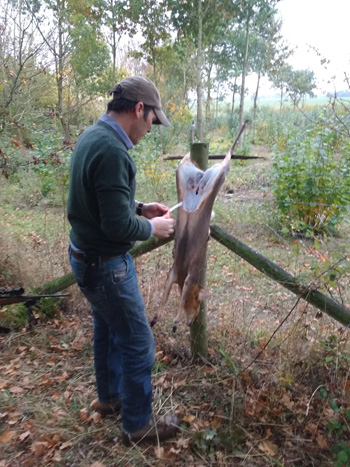
Muntjac deer – introduced by the Duke of Bedford and causing grief in woodlands
It would be easy to be critical of some individuals amongst our forebears. Actually that’s true in a much wider sense than the one of which I was just thinking. In this case however, I’m thinking of those probably well-meaning people in the past who thought it would be a good idea to move species, both plant and animal, around the world.
Some introductions have been accidental and I suppose the most infamous example might be the black rat and more particularly the fleas it carried from Asia into fourteenth century Europe. Those introductions had ramifications that highlight the relatively trivial nature of what I’m about to grumble about.
Some have been well intentioned and a good example of such good intentions is a cane toad introduced to Australia from Hawaii in the 1930s in an attempt to control a native beetle that was causing damage to introduced sugar cane. Unfortunately, the toads hadn’t been in on the plan and as well as the target beetle, it rather enjoyed many other items of native fauna. Local predators also suffered when eating large toads, being unable to cope with the toxins carried by the skin on the toad’s back. The toad, even now, advances west from its point of introduction in the Northern Territories. Australia and New Zealand both have terrible records of alien introductions; often by Europeans. But that’s the subject of another post.
In Britain we live with several well known introduced mammals – rabbits and fallow deer were apparently brought to these shores by the Normans. Grey squirrels were a mere fancy, introduced in the 1870s, presumably to beautify country estates, the culprits having no knowledge of or perhaps taking no time to consider the effects of their actions.
But it’s muntjac deer that are exercising my ire right now. Brought to Britain in the early 20th century by the Duke of Bedford to enhance his deer collection, they now have a range that covers a large part of England. These small, shy deer are woodland specialists and are causing problems in woodlands wherever they are. Unlike many other deer species, the muntjac is a solitary and territorial beast that breeds throughout the year. They like dense cover and are quite at home in an overgrown garden, but of course early stages of a coppice rotation are particularly favoured. When we planted Bottoms’ Corner, we compromised on fencing and went to about 4’6″ feet tall to avoid the huge cost of proper deer fences. For several years these worked fine but probably only because the limited cover within was of little interest. Now that there is effectively a wood inside, it’s worth a muntjac’s while to make the effort. And they do. I’ve spent many hours trying to maintain the fence in as good an order as possible but realised that these animals have springs for legs and are able to clear the fence from a standing start without breaking into a sweat. They can even dive through the gaps between line wires. In the wood, they are beginning to cause quite noticeable damage by browsing the new hazel regrowth each spring. And that’s important. If it gets as bad as it was last spring again, we are in trouble.
During a recent visit to Hayley Wood in Cambridgeshire, in the company of the East Anglian Coppice Group and Andy Ricketts from the Wildlife Trust, we heard that muntjac can get through a 9 inch diameter hole and fences really aren’t that effective against them, over a long period of time. It seems that after a roughly 20 year period of ‘fence your wood’ advice, the general wisdom now might be moving towards ‘shoot the deer in the wood’. And that’s what we are trying to do. During the winter, our friendly stalker visits regularly and removes deer. Killing an animal always makes me pause for thought. In this case, I’m content that the killing is necessary; the muntjac really shouldn’t be here, the kill is very swift when carried out by an expert and the carcase provides good, healthy meat.
